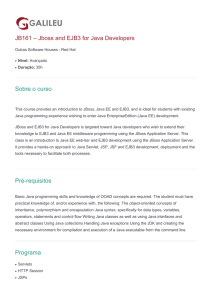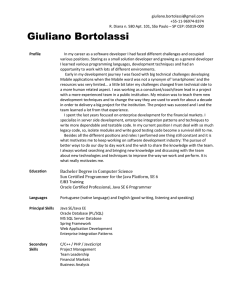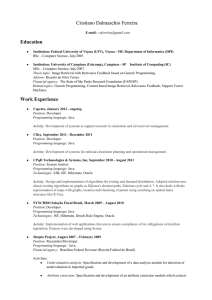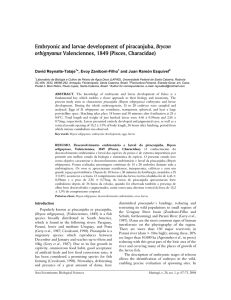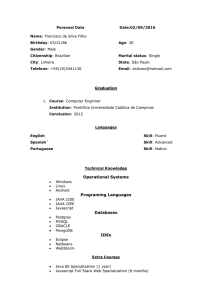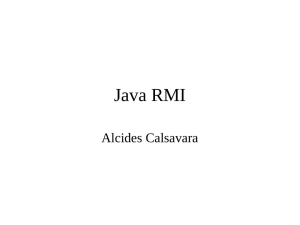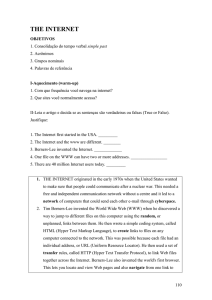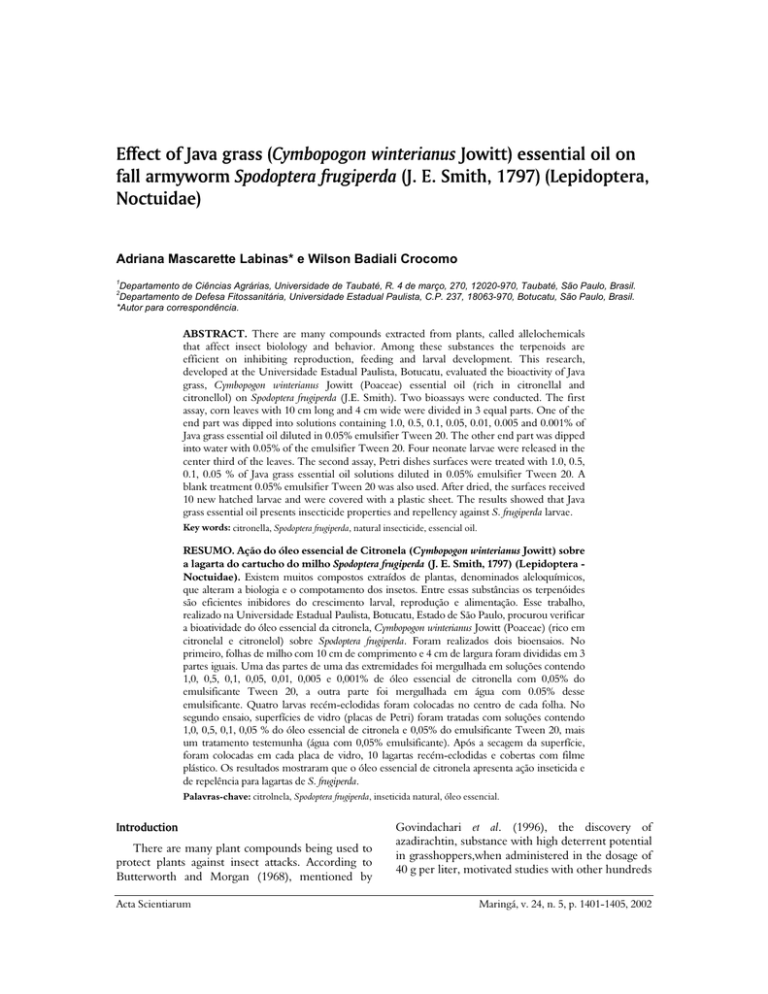
Effect of Java grass (Cymbopogon winterianus Jowitt) essential oil on
fall armyworm Spodoptera frugiperda (J. E. Smith, 1797) (Lepidoptera,
Noctuidae)
Adriana Mascarette Labinas* e Wilson Badiali Crocomo
1
Departamento de Ciências Agrárias, Universidade de Taubaté, R. 4 de março, 270, 12020-970, Taubaté, São Paulo, Brasil.
Departamento de Defesa Fitossanitária, Universidade Estadual Paulista, C.P. 237, 18063-970, Botucatu, São Paulo, Brasil.
*Autor para correspondência.
2
ABSTRACT. There are many compounds extracted from plants, called allelochemicals
that affect insect biolology and behavior. Among these substances the terpenoids are
efficient on inhibiting reproduction, feeding and larval development. This research,
developed at the Universidade Estadual Paulista, Botucatu, evaluated the bioactivity of Java
grass, Cymbopogon winterianus Jowitt (Poaceae) essential oil (rich in citronellal and
citronellol) on Spodoptera frugiperda (J.E. Smith). Two bioassays were conducted. The first
assay, corn leaves with 10 cm long and 4 cm wide were divided in 3 equal parts. One of the
end part was dipped into solutions containing 1.0, 0.5, 0.1, 0.05, 0.01, 0.005 and 0.001% of
Java grass essential oil diluted in 0.05% emulsifier Tween 20. The other end part was dipped
into water with 0.05% of the emulsifier Tween 20. Four neonate larvae were released in the
center third of the leaves. The second assay, Petri dishes surfaces were treated with 1.0, 0.5,
0.1, 0.05 % of Java grass essential oil solutions diluted in 0.05% emulsifier Tween 20. A
blank treatment 0.05% emulsifier Tween 20 was also used. After dried, the surfaces received
10 new hatched larvae and were covered with a plastic sheet. The results showed that Java
grass essential oil presents insecticide properties and repellency against S. frugiperda larvae.
Key words: citronella, Spodoptera frugiperda, natural insecticide, essencial oil.
RESUMO. Ação do óleo essencial de Citronela (Cymbopogon winterianus Jowitt) sobre
a lagarta do cartucho do milho Spodoptera frugiperda (J. E. Smith, 1797) (Lepidoptera Noctuidae). Existem muitos compostos extraídos de plantas, denominados aleloquímicos,
que alteram a biologia e o compotamento dos insetos. Entre essas substâncias os terpenóides
são eficientes inibidores do crescimento larval, reprodução e alimentação. Esse trabalho,
realizado na Universidade Estadual Paulista, Botucatu, Estado de São Paulo, procurou verificar
a bioatividade do óleo essencial da citronela, Cymbopogon winterianus Jowitt (Poaceae) (rico em
citronelal e citronelol) sobre Spodoptera frugiperda. Foram realizados dois bioensaios. No
primeiro, folhas de milho com 10 cm de comprimento e 4 cm de largura foram divididas em 3
partes iguais. Uma das partes de uma das extremidades foi mergulhada em soluções contendo
1,0, 0,5, 0,1, 0,05, 0,01, 0,005 e 0,001% de óleo essencial de citronella com 0,05% do
emulsificante Tween 20, a outra parte foi mergulhada em água com 0.05% desse
emulsificante. Quatro larvas recém-eclodidas foram colocadas no centro de cada folha. No
segundo ensaio, superfícies de vidro (placas de Petri) foram tratadas com soluções contendo
1,0, 0,5, 0,1, 0,05 % do óleo essencial de citronela e 0,05% do emulsificante Tween 20, mais
um tratamento testemunha (água com 0,05% emulsificante). Após a secagem da superfície,
foram colocadas em cada placa de vidro, 10 lagartas recém-eclodidas e cobertas com filme
plástico. Os resultados mostraram que o óleo essencial de citronela apresenta ação inseticida e
de repelência para lagartas de S. frugiperda.
Palavras-chave: citrolnela, Spodoptera frugiperda, inseticida natural, óleo essencial.
Introduction
There are many plant compounds being used to
protect plants against insect attacks. According to
Butterworth and Morgan (1968), mentioned by
Acta Scientiarum
Govindachari et al. (1996), the discovery of
azadirachtin, substance with high deterrent potential
in grasshoppers,when administered in the dosage of
40 g per liter, motivated studies with other hundreds
Maringá, v. 24, n. 5, p. 1401-1405, 2002
1402
of vegetable compounds with insecticidal activity
during the last decades.
Aerts and Mordue (1997), working with
triterpenoids extracted from Azadirachta indica,
verified high deterrent activity when tested on
Spodoptera littoralis Boisduval larvae and on Schistocerca
gregaria Forskal nymphs.
According to Pickett (1991), efficient insecticide
was obtained from plants since pirethrina I
(component with the highest insecticide activity),
extracted from Chrysanthemum cinerariefolium.
Bloem et al. (1989) listed lots of substances that
affect insects’ biology and behavior. Saponins,
extracted from various plants, showed to be efficient
on inhibiting Tribolium casteneum Herbst larval
growing. Terpenoids glycosids taken out from organ
pipes inhibited the development of Drosophila
nigrospiracula Patterson. Glycoalkaloids from potato
really affected Leptinotarsa decemlineata Say feeding, as
well as the survival of Empoasca fabae Harris nymphs.
The tomatine glycoalkaloid from tomato plants has
shown a potent inhibitor in the development of
Helicoverpa zea Boddie larvae.
Lindroth and Peterson (1988) evaluated the
effect of two classes of phenols (the most abundant
group of allelochemicals) on the performance (e.g.
food intake, growing rate) during the last instars of
Spodoptera eridania Cramer. These components
caused on treated larvae an increase in mortality and
a decrease of food intake and digestibility resulting
in reduction in the larval growing rate.
Ahmad et al. (1993) presented a wide review
about plant substances that act as insecticides,
fungicides and nematicides, mentioning their
dosages, indications, application methods and
biological targets.
Cowles et al. (1990) studying the deterrent effects
of some cynamic derivatives and monoterpenoids
like citronellol and citronellal in Delia antiqua
Meigen, verified no oviposition with BR90
(concentration needed to cause 90% of deterrency
on oviposition) of 0,88% and 3,7%, respectively. The
contrast between citronellal and citronellol seems to
indicate that the alcohol form shows more activity
than the aldehydic one.
According to Khambay and O`Conor (1993) the
identification key of insecticidal activities of these
compounds is the availability of bioassays that
requires “in vivo” analysis, sampling, application
methods ( contact or residual) and the decision about
the level of compound efficiency. So Spodoptera
frugiperda (J. E. Smith), was the used specie because of
its economic importance and its well known biology
and behavior, which would permit the understanding
Acta Scientiarum
Labinas & Crocomo
of the results obtained from the experimentation with
Java grasss (Cymbopogon winterianus Jowitt) (Poaceae)
essential oil, aiming to verify its insecticidal and
repellency activities.
Material and methods
This research was conducted at the Universidade
Estadual Paulista “Júlio de Mesquita Filho” ,
Departamento de Defesa Fitossanitária - Botucatu
(SP). The assays were performed at 25 +/- 2 °C, RH
70% and 14 h photophase, consisting of S. frugiperda
rearing on artificial diets (proposed by Nalin, 1991)
with different concentrations of Java grass (C.
winterianus) essential oil.
Initially, S. frugiperda eggs were obtained from
Esalq-USP and Rhodia Agro Ltda laboratories
rearing. From these eggs it was established a stock
rearing to produce insects to conduct this research.
The Java grass, C. winterianus, was grown in field
on São Manoel Experimental Farm and the essential
oil was obtained from distillation of plants leaves.
The extracted oil was chemically analyzed at the
Instituto Agronômico de Campinas (IAC) and
presented the following composition: citronellal
(42,15%), citronellol (22,03%) and geraniol
(16,44%), indicating that more than 80% of the oil
had the constituents reported in the literature with
insecticidal activity (Carrol, 1994).
The first assay corn leaves 10 cm long and 4 cm
wide were marked into 3 equal parts. One end part
was dipped into a solution, previously prepared with
the following Java grass essential oil concentrations
1.0%, 0.5%, 0.1%, 0.05%, 0.01%, 0.005% and 0.001%
plus 0.05% of emulsifier Tween 20. The other end
part was dipped in blank treatment, water with
0.05% of Tween 20.
After the solution was drained, the leaves, were
placed on a white paper sheet on a table to dry out the
water. Four neonate larvae were placed on the center
third of each leave. After 2, 15, 30 and 60 minutes of
larval inoculation, their behavior was evaluated
verifying which part of the leaf they preferred: the
treated third with its correspondent concentration, the
third in the opposite side of the leaf with blank
treatment or the middle one with no treatment (where
larvae were released). To avoid the light attractive effect
on the larvae, the leaves were distributed following a
randomized design on a table placed in the center of a
16 m2 room, with white walls, exclusively illuminated
with eight 40 Watts fluorescent lamps (daylight). Each
treatment was repeated eight times.
The second assay glass surfaces (Petri dishes)
were treated with 1.0%, 0.5%, 0.1%, 0.05% solutions
of Java grass essential oil plus 0.05% of the
Maringá, v. 24, n. 5, p. 1401-1405, 2002
Effect of Java grass on fall armyworm
Table 1. Number of living larvae on treated and non treated areas of
corn leaves with Java Grass essential oil against S. frugiperda larvae.
Temperature 25+/-2°C, RH 70% and Photophase 14 h
1.0
Average
0.5
Average
0.1
Average
0.05
Average
0.01
Results
Acta Scientiarum
Average
0.005
Average
0.001
Time
Average
Average of Average
Untreated Conc.x Concentr. Time
Time
Treated
2 min
15 min
30 min
60 min
0.50 4
1.00 4
1.25 4
0.25 4
7.50 123
6.00 123
5.25 123
6.00 123
4.00 a
3.50 a
3.25 a
3.12 a
2 min
15 min
30 min
60 min
0.75 B b
0.00 4
0.00 4
1.00 4
0.00 4
6.18 A b
7.75 12
6.75 123
6.25 123
6.50 123
3.87 a
3.37 a
3.62 a
3.25 a
2 min
15 min
30 min
60 min
0.25 B b
0.50 4
0.50 4
0.50 4
0.00 4
6.81 A ab
7.25 123
6.75 123
7.00 123
6.25 123
3.87 a
3.62 a
3.75 a
3.12 a
2 min
15 min
30 min
60 min
0.37 B b
0.25 4
1.00 4
0.50 4
0.00 4
6.81 A ab
7.75 12
7.00 123
7.00 123
7.25 123
4.00 a
4.00 a
3.75 a
3.62 a
2 min
15 min
30 min
60 min
0.43 B b
1.00 4
0.75 4
0.25 4
0.50 4
7.25 A a
6.25 123
6.50 123
7.00 123
6.50 123
3.62 a
3.62 a
3.62 a
3.50 a
2 min
15 min
30 min
60 min
0.62 B b
0.50 4
0.25 4
0.25 4
0.50 4
6.56 A ab
7.50 123
6.75 123
6.50 123
6.50 123
4.00 a
3.50 a
3.37 a
3.50 a
2 min
15 min
30 min
60 min
0.37 B b
1.25 4
2.25 4
1.75 4
2.00 4
6.81 A ab
5.50 123
5.25 123
5.00 1
4.75 12
3.37 a
3.75 a
3.37 a
3.37 a
2 min
15 min
30 min
60 min
1.81 B a
5.12 A c
Condition X Time
0.57 B a
7.07 A a
0.82 B a 6.42 A ab
0.78 B a
6.28 A b
0.55 B a
6.25 A b
Average
Average
condition
0.66 B
3.47 a
3.53 a
3.59 a
3.84 a
3.59 a
3.59 a
3.47 a
3.82 a
3.62 ab
3.53 ab
3.35 b
6.50 A
Capital letters compare the average on lines and small letters on columms; Numeric
indexes compare the averages of treated and untreated, at different times, for each
concentration; Averages followed by the same letters or numbers do not differ by
Tukey test at 5% of probability
120
a
a
80
60
40
b
%
1,
00
%
0,
50
st
m
un
h
a
0
%
b
b
0,
10
20
%
Mortality (%)
100
Te
In the assay where the neonate larvae were
released on corn leaves that had one of its third
treated with Java grass essential oil, the treated areas
were avoided by the larvae, mainly in the treatments
with higher concentrations.
A significantly lower larval number was observed
on treated parts of leaf surface than on untreated one
(Table 1). The number of arrested larvae on the
treated parts of leaves with 0,001% of Java grass
essential oil was significantly higher than the other
treatments, indicating that the arrested behaviour
was less affected by the lower concentrations.
During this experimental period, there was no
variation in the arrested larvae number to the treated
part of leaves surface, indicating the repellency
occurred immediately after the first larval contact
with citronella oil. During the observation period,
on untreated part of leaf surface, it was verified
differences in the larval number, indicating larval
mobility. These larvae left the untreated part of leaf
surface going to other parts except those which
received the Java grass essential oil treatments,
confirming its repellency (Table 1).
The assay where the neonate larvae were released
on glass treated surface showed larval mortality
ranging from 1.00 e 0.50% of essential oil solutions
was significantly greater than the other two solutions
(0.1 e 0.05 %) (Figure 1). The observed mortality to
the lower concentrations was equivalent to the
check treatment. The correlation between java grass
essential oil concentration and larval mortality
showed high significance (Figure 2).
Condition
Concentration
(%)
0,
05
emulsifier Tween 20. The check treatment received
water with 0.05% of Tween 20 instead of oil. After
dried, the Petri dishes ( 15 cm diameter) received 10
neonate larvae and were covered with a plastic sheet.
Each treatment was repeated five times, following a
randomized design, in a room with the same
conditions as the first assay. After 90 minutes the
mortality percentage was evaluated.
The 0,05% of the emulsifier Tween 20 (ICI
Americas Inc.) added to the aqueous solutions was
necessary due to the oil nature of this vegetable
extract. Thus, all treatments received this emulsifier
concentration, including the blank.
The concentration, time and condition (treated
and no treated) data were submitted to factorial
analysis (7 doses x 4 times x 2 conditions) with the
respective interactions and the averages were
compared by Tukey test at 5% of probability. The
larval mortality data were correlated with doses of
Java grass essential oil by linear regration analises
1403
Trea tments
Figure 1. Larval mortality on glass treated surfaces. Temperature
25+/-2°C, RH 70%, and Photophase 14 h
Maringá, v. 24, n. 5, p. 1401-1405, 2002
1404
Labinas & Crocomo
Concluding, the Java grass essential oil shows
repellency and insecticide properties to S. frugiperda
larvae. The total mortality of S. frugiperda larvae
occurred next to the concentrations of 1.0 %.
12
Larval mortality
10
8
6
y = 10,167x + 0,8448
4
2
R = 0,7573
r = 0,87**
2
0
0,00
0,20
0,40
0,60
0,80
1,00
1,20
Java grass essential oil concentration
Figure 2. Correlation between java grass essential oil and larval
mortality. Temperature 25+/-2°C, RH 70%, and Photophase 14 h
Discussion
Ouden et al. (1996) studying repellent effect of
some plant substances to Delia radicum Linneaus
detected aldehyde citronellal did not exhibit the
repellency effect as expected and the reason could be
its volatilization.
As larvae were released on the Petri dishes
immediately after they became dried and they were
covered with a plastic film. It was not possible to
distinguish the contact effect from the effect caused
by the volatilization of the essential oil. In the first
assay there was not volatilization effects due to the
short period of evaluation.
The results indicated no relationship between
the concentrations and mortality (Figure 1) which
was not observed in great part of the assays discussed
by Labinas (1998), who studied the effects of Java
grass essential oil added to artificial diets used to
study the S. frugiperda biology and behavior. As
citronella oil is a natural substance, several problems
occurred during the manipulation process, which
explains the reason that Labinas (1998) did not find
any relation between concentration and mortality.
The monoterpenoid structure characteristics that
constitute Java grass essential oil (C. winterianus) may
influence its insecticide properties. The saturation
level and the functional group present in the
molecules influence the penetration of these
substances through insect cuticule, may affect the
movement and the interactions between these and
other molecules, as well as their degradation.
Besides the unknown way of action, acute, subacute and lethal effects have been discussed. The
results show that monoterpenoids can act as
insecticide but their action greatly vary and all
structure modification in the molecule can result in
big differences in their toxicity (Rice and Coats,
1994).
Acta Scientiarum
Acknowledgements
The authors are grateful to Dr. Lin Chau Ming
for his criticism and suggestions during this
research.
References
AERTS, R.J.; MORDUE A.J. Feeding deterrence and
toxicity of neem triterpenoids. J. Chem. Ecol, New York, v.
23, n. 1, p. 2116-32. 1997.
AHMAD, R. et al. Essential oils as insect attractants and
repellents. Hamdard Med., Karachi, v. 36, n. 1, p. 99-105.
1993.
BLOEM, K.A. et al. Differencial effect of tomatine and its
alleviation by cholesterol on larval growth and efficiency
of food utilization in Heliothis zea and Spodoptera exigua. J.
Chem. Ecol., New York, v. 15, n. 1, p. 387-98. 1989.
CARROL, J.F. Feeding deterrence of northern fowl mites
(Acari: Macronyssidae) by some naturally occurring plant
substances. Pestic Sci., Barking, v. 41, n. 1, p. 203-7. 1994.
COWLES, R.S. et al. Cinnamyl derivatives and
monoterpenoids as nonspecific ovopositional deterrents of
the onion fly. J. Chem. Ecol., New York, v. 16, n. 1, p.
2401-28. 1990.
GOVINDACHARI, T.R. et al. Insect antifeedant and
growth-regulating activities of salanin and other c-seco
limonoids from neem oil in relation to azadirachtin. J.
Chem. Ecol., New York, v. 22, n. 1, p. 1453-61. 1996.
KHAMBAY, B.P.S.; O’CONOR N. Progress in
developing insecticides from natural compounds, In:
BEEK T.A.; BRETELER H. (Ed.). Phytochemistry and
agriculture. Oxford: Clarendon, 1993. cap.2, p. 40-61.
LABINAS, A.M. Efeito do óleo essencial de citronela
(Cymbopogon winterianus Jowitt) na biologia e no
comportamento da lagarta do cartucho do milho (Spodoptera
frugiperda J. E. Smith, 1797). 1998. Dissertação (Mestrado)
- Faculdade de Ciências Agronômicas, Universidade
Estadual Paulista, Botucatu, 1998.
LINDROTH, R.L.; PETERSON, S.S. Effects of plant
phenols on performance of southern armyworm larvae.
Oecologia, Berlin, v. 75, n. 1, p. 185-9. 1988.
NALIN, D. N. Biologia, nutrição quantitativa e controle de
qualidade de populações de Spodoptera frugiperda (J.E. Smith,
1797) - (Lepidoptera: Noctuidae) em duas dietas artificiais.
1991. Tese (Doutorado) - Escola Superior de Agricultura
Luiz de Queiroz, Universidade de São Paulo, Piracicaba,
1991.
OUDEN, H. D. et al. Delia radicum (L.) (Diptera:
Anthomyiidae). J. Appl. Entomol., Oxford, v. 120, p. 42732. 1996.
PICKETT, J.A. Lower terpenoids as natural insect control
agents, In: HARBONE J.B., TOMAS-BARBERAN F.A.
Maringá, v. 24, n. 5, p. 1401-1405, 2002
Effect of Java grass on fall armyworm
(Ed.). Ecological chemistry and biochemistry of plant terpenoids.
Oxford, Claredon, 1991. cap. 8, p.297-313.
RICE, P.J.; COATS J.R. Insecticidal properties of several
monoterpenoids to the house fly (Diptera: Muscidae), red
flour beetle (Coleoptera: Tenebrionidae) and southern
Acta Scientiarum
1405
corn rootworm (Coleoptera: Chrysomelidae). J. Econ.
Entomol., Lanham, v. 87, n. 1, p. 1172-9. 1994.
Received on November 29, 2001.
Accepted on July 10, 2002.
Maringá, v. 24, n. 5, p. 1401-1405, 2002



